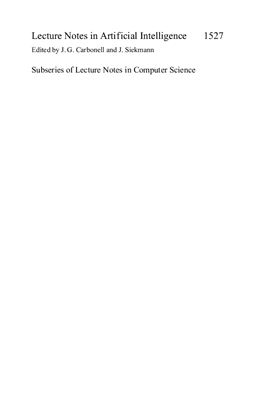Издательство Springer, 1998, -289 pp.
Certainly, the ability to draw inferences is a central operation in any Artificial Intelligence (AI) system. Consequently, automated deduction is one of the most traditional disciplines in AI. One core technique, the resolution principle [Robinson, 1965b] nowadays even seems to be standard knowledge for any computer scientist.
Although resolution is particularly well suited for implementation on a computer, it became clear soon after its invention that even more elaborate techniques are needed to cope with the tremendous search space. One of these techniques is theory reasoning, where the idea is to incorporate specialized and efficient modules for handling general domain knowledge into automated reasoning. These theory reasoning modules might, for instance, simplify a goal, compute solutions, look up facts in a database, etc. Also, the most suitable knowledge representation formalism might be used for this.
This book is on extensions of calculi for automated theorem proving to- ward theory reasoning. It focuses on connection methods and in particular on model elimination. An emphasis lies on the combination of such calculi with theory reasoners to be obtained by a new compilation approach.
Several theory-reasoning versions of connection calculi are defined and related to each other. In doing so, theory model elimination (TME) will be selected as a base to be developed further. The final versions are search-space restricted versions of total TME, partial TME, and partial restart TME. These versions all are answer-complete, thus making TME interesting for logic programming and problem-solving applications.
A theory reasoning system is only operable in combination with an (efficient) background reasoner for the theories of interest. Instead of hand- crafting respective background reasoners, a more general approach - linearizing completion - is proposed. Linearizing completion enables the automatic construction of background calculi suitable for TME-based theory reasoning systems from a wide range of axiomatically given theories, namely Ho theories.
Technically, linearizing completion is a device for combining the unit- resulting strategy of resolution with a goal-oriented, linear strategy as in Prolog in a refutationally complete way.
Finally, an implementation extending the PTTP technique (Prolog based Technology Theorem Proving) toward theory reasoning is described, and the usefulness of the methods developed in this text will be experimentally demonstrated.
This book was written during my employment1 as a research assistant at the institute for computer science at the University of Koblenz-Landau in Germany. It is the revised version of a doctoral dissertation submitted and accepted at this institute.
Introduction
Logical Background
Tableau Model Elimination
Theory Reasoning in Connection Calculi
Linearizing Completion
Implementation
Conclusions
A. Proofs
B. What is Where?
Certainly, the ability to draw inferences is a central operation in any Artificial Intelligence (AI) system. Consequently, automated deduction is one of the most traditional disciplines in AI. One core technique, the resolution principle [Robinson, 1965b] nowadays even seems to be standard knowledge for any computer scientist.
Although resolution is particularly well suited for implementation on a computer, it became clear soon after its invention that even more elaborate techniques are needed to cope with the tremendous search space. One of these techniques is theory reasoning, where the idea is to incorporate specialized and efficient modules for handling general domain knowledge into automated reasoning. These theory reasoning modules might, for instance, simplify a goal, compute solutions, look up facts in a database, etc. Also, the most suitable knowledge representation formalism might be used for this.
This book is on extensions of calculi for automated theorem proving to- ward theory reasoning. It focuses on connection methods and in particular on model elimination. An emphasis lies on the combination of such calculi with theory reasoners to be obtained by a new compilation approach.
Several theory-reasoning versions of connection calculi are defined and related to each other. In doing so, theory model elimination (TME) will be selected as a base to be developed further. The final versions are search-space restricted versions of total TME, partial TME, and partial restart TME. These versions all are answer-complete, thus making TME interesting for logic programming and problem-solving applications.
A theory reasoning system is only operable in combination with an (efficient) background reasoner for the theories of interest. Instead of hand- crafting respective background reasoners, a more general approach - linearizing completion - is proposed. Linearizing completion enables the automatic construction of background calculi suitable for TME-based theory reasoning systems from a wide range of axiomatically given theories, namely Ho theories.
Technically, linearizing completion is a device for combining the unit- resulting strategy of resolution with a goal-oriented, linear strategy as in Prolog in a refutationally complete way.
Finally, an implementation extending the PTTP technique (Prolog based Technology Theorem Proving) toward theory reasoning is described, and the usefulness of the methods developed in this text will be experimentally demonstrated.
This book was written during my employment1 as a research assistant at the institute for computer science at the University of Koblenz-Landau in Germany. It is the revised version of a doctoral dissertation submitted and accepted at this institute.
Introduction
Logical Background
Tableau Model Elimination
Theory Reasoning in Connection Calculi
Linearizing Completion
Implementation
Conclusions
A. Proofs
B. What is Where?

